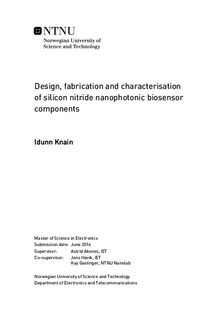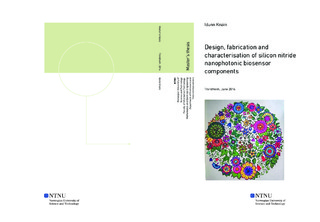| dc.description.abstract | This master thesis is dedicated to silicon photonic components; their design, fabrication and characterisation. Waveguides are the fundamental component in the new and exciting field of interferometric biosensors. Their property to confine light and their high sensitivity towards refractive index changes makes them suitable parts of sensitive, miniaturised and fast diagnostic devices. Silicon nitride has been chosen as the core material as it is transparent to the chosen wavelength at 632.8 nm has low losses.
Much work has been done on designing and optimising the waveguide design. The properties behind the various photonics components have been found through simulations done using the finite element method simulation software COMSOL Multiphysics. The optimal dimensions were found to insure single-mode conditions. Propagation and bend losses were estimated as well as coupling between parallel waveguides.
In addition to carrying out simulations of waveguides to minimise losses, experimental characterisation is also needed to validate the performance. Test plans for finding propagation, bend and taper losses were proposed. A paper-clip design was made which is a cut-back method used to characterise propagation loss by measuring waveguides of different lengths. Losses due to side-wall roughness are found by measuring propagation loss depending on waveguide core width.
Fabrication methods for silicon nitride waveguides were investigated and optimised. Equipment used to fabricate the waveguides were plasma-enhanced chemical vapor deposition, inductively coupled plasma reactive-ion etching and electron beam lithography. When a coupling test was carried out, it was apparent that the material properties of the silicon nitride and the silicon oxide resulted in large losses in the waveguide. The etch recipes tried in this thesis gave various etch rates and resulted in anisotropic waveguides with only approximately 90 degree walls. Sidewall roughness was also observed. | |

